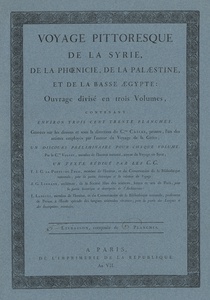| Method | Copper engraving |
| Artist | Louis-François Cassas |
| Published | A Paris, de l'Imprimerie de la Republique. An. VII. [1799] |
| Dimensions | Each folio ~575 x 395 mm |
| Notes |
A pair of complete livraisons of 6 plates each of Louis-François Cassas' incomplete but impressively large series of illustrations of the Holy Land and Egypt, originally intended to encompass 30 livraisons of text and plates which Cassas began issuing in parts from 1799 after his return to Paris following the outbreak of the Revolution. The full series, once completed, was to contain more than 300 engravings based on Cassas' own drawings and paintings in oil and watercolour, but although the full number of completed plates is unknown, the most complete examples in instituitional collections feature between 170 and 190 plates, with only seven sections of text. The current example comprises two livraisons, numbered in original manuscript as numbers 5 and 12, of plates relating to Palmyra. Both are unbound as issued, in their original blue paper wrappers, with flypapers separating the plates, and with letterpress indices of plates for both on smaller slips. Included also is the original seven-sheet Prospectus for the full series. Plates are as follows: Livraison 5, Palmyre I I.re Planche. Plan d'un Arc de Triomphe, a Palmyre. [Tome I, No. 65] II.e Planche. Arc de Triomphe a Palmyre, Elevation Geometrale. [Tome I, No. 68] III.e Planche. Foret des Cedres sur le Mont Liban. [Tome II, No. 59] IV.e Planche. Tombeau d'Iamblichus, a Palmyre. [Tome I, No. 113] V.e Planche. Tombeau d'Iamblichus, a Palmyre. [Tome I, No. 114] VI.e Planche. Cours du Nahr Qades (ou Fleuve Saint). [Tome II, No. 62] Livraison 12, Palmyre II I.re Planche. Coenotaphe de Caius Caesar. [Tome I, No. 22] II.e Planche. Vue de la Partie la Mieux Conservee de la Grande Gallerie de Palmyre. [Tome I, No. 53] III.e Planche. Arc de Triomphe a Palmyre. [Tome I, No. 66] IV.e Planche. Mausolee d'Iamblichus. [Tome I, No. 105] V.e Planche. Mausolee d'Elabelus. [Tome I, No. 124] VI.e Planche. Troisieme Vue du Chemin d'Antonin, Avant d'Arriver a Baruth. [Tome II, No. 78] Louis-François Cassas (1756-1827) was a French artist, architect, and antiquarian, best known for his copiously illustrated travel books on Rome, Dalmatia, Greece, and the Near East and Egypt. Following a youth studying painting and architecture in Paris, Tours, Rome, Venice, Naples, and Sicily, Cassas was sent to Istria to document the antiquities of the Dalmatian coast, before embarking on a similar tour across Greece and the Aegean coast of Turkey while in the employ of Count Choiseul-Gouffier, ambassador to the Ottoman court. Beginning in 1785, Cassas began a comprehensive tour of Egypt, Syria, Lebanon, Palestine, and Cyprus. The many drawings and paintings he undertook during this period formed the basis for his largest and best known series, the Voyage Pittoresque de la Syrie, de la Phenicie, de la Palestine, et de la Basse Egypte. Having returned to Paris following the outbreak of the Revolution, Cassas spent the next decade publishing his various Voyages, and later in life became Inspector General of the Gobelins Manufactory. Condition: Paper wrappers slightly chipped and worn on edges. Plates clean and crisp, with deckled edges on three sides as issued. |
| Framing | Folio |
| Price | £3,000.00 |
| Stock ID | 52822 |

